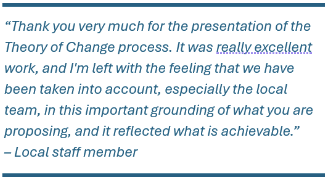The Theory of Change Workbook: Use Cases for Climate Change Programming from Iraq and Bolivia
We used the Theory of Change Workbook to guide two processes in our current project portfolio. In the first case, we revisited an existing Theory of Change (ToC) to move into the second phase of the project. In the second instance, we used it to formulate a new ToC for a project proposal.
Use Case #1: Revising an existing Theory of Change
In the first case, revising the ToC allowed us to review what we had accomplished in the previous project phase and recognize how our results were somewhat disconnected from our actual achievements. Revisiting the ToC brought the entire team back on track, provided a common vision, and highlighted that entry points had significantly shifted due to political changes and new agendas. This also facilitated productive working sessions with the local team and partners, helping us create realistic activities that addressed concerns and needs from different perspectives. We involved the local team, which consists of six technical specialists and two managers and organized it into four sessions, each one covering the four elements of a ToC: contextual factors, entry points, impacts and outcomes, and potential activities / interventions.
Use Case #2: Creating a new Theory of Change for a proposal
For the new project, the ToC process enabled us to better understand the problem we were trying to tackle and its root causes. It equipped us with the right tools to ask relevant questions and design project activities that are realistic and context-specific.
In this case, only our research team was involved since we do not yet have partners on the ground. However, we plan to replicate the process with local partners in the autumn, aiming to gather more contextualized data.
What went well? What could have been better?

The workshops ran smoothly and the process made everyone in the team feel involved and valued (see quote). The ToC narrative examples available on USAID Learning Lab were extremely helpful in understanding how the different parts are woven together.
What could have gone better:
- Session structure: Sometimes the sessions felt heavy because we tried to answer too many questions at once, and it was difficult not to get caught up in lengthy discussions on a single topic. Narrowing down the questions could have helped keep participants focused.
- Cross-sectoral collaboration: Although the workshops went well within our sector-specific team, I would involve colleagues from other teams if we were to do this again. However, this would require some time and effort allocated from the project budget.
What’s your advice for others thinking of using the ToC Workbook?
- Facilitator: Having a facilitator who knows the process and can identify which questions make sense for your project is incredibly beneficial.
- Learn from Social Impact's experience: Watch the webinar hosted by Social Impact to understand how they approached the process and what worked and didn't work for them.
- Reach out for support: Reach out to Social Impact colleagues (Monalisa Salib) if you have any questions. I reached out and they provided additional material for a specific section that my team and I were struggling with.
Additionally, it would be very helpful to have more case study examples showing how information is organized in different sections of the ToC from other projects. I recommend others who try the process to share their final ToCs! Our ToC narrative and figure from Bolivia is here (en español).



